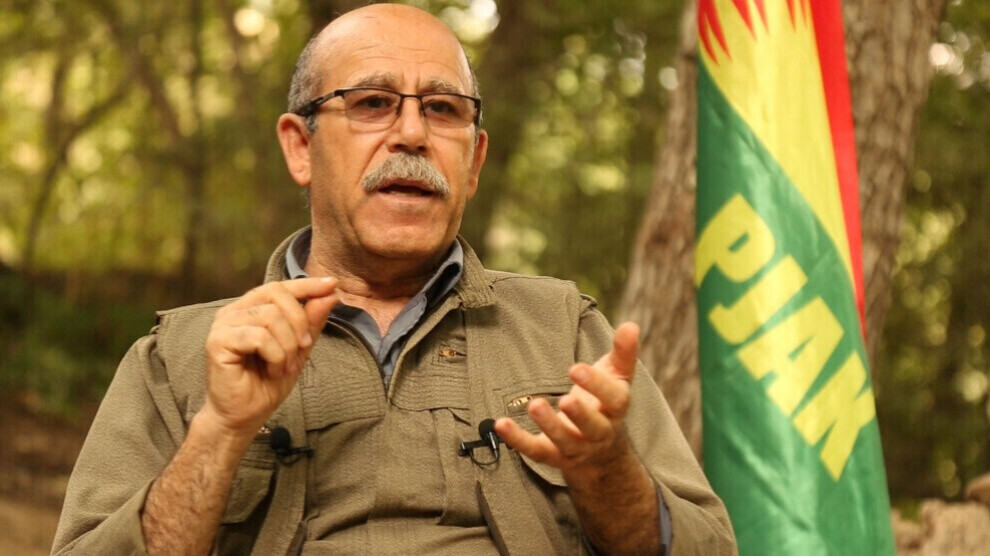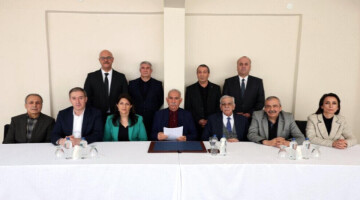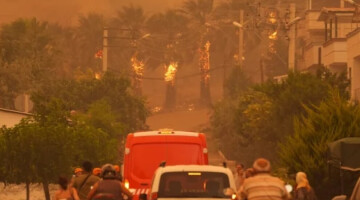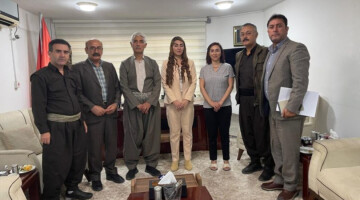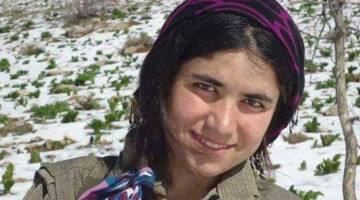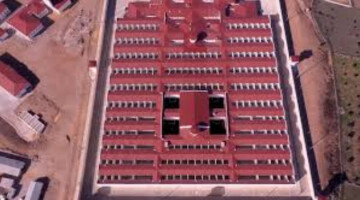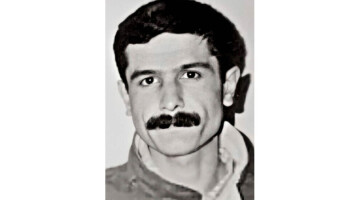The uprising in Eastern Kurdistan and Iran for freedom and self-determination has left 39 days behind, and the mullahs' regime continues to react with full force: more than 200 people have been killed so far, at least 40 of them in Rojhilat. But there are no signs of the insurgency abating. In Mahabad, another general strike was called at the weekend, and, despite a heavy presence of security forces, large numbers of people took to the streets in the evening, chanting "Jin, Jiyan, Azadî" (Woman, Life, Freedom) and "Death to the dictator". Protests against the regime were also held in Sine (Sanandaj), Seqiz (Saqqez), Kirmaşan (Kermanshah), Dêwlan (Dehgolan) and Bokan. Shots were reportedly fired again in Sine, and in Kirmaşan, students from Razi University chanted "We will fight, we will die, we will take back Iran". A strike announced by the Coordinating Council of Teachers' Unions also began yesterday.
The co-chair of PJAK (Party for a Free Life in Kurdistan), Siamand Moini, sees Kurdistan as the centre of the revolution in Iran. In an interview with RojNews, Moini spoke about the current situation in the country, his party's project and the importance of a common stance among all resisters.
In your opinion, what is the difference between the current uprising, which was ignited by the violent death of Jina Mahsa Amini, and previous protest movements?
Dictatorships and conservative systems have their own truths based on a certain limitation and rejection of other ideas. These systems generally oppose any form of social and personal freedom. They do not accept any path that opens to freedom. The Islamic Republic of Iran operates in this consciousness and from a militaristic perspective. This is how the patriarchal system has been maintained. It is perfectly natural to call this regime sectarian and fascist. It never tried to find solutions. Therefore, protests have been continuously organised by different classes and groups in Iran. However, the current demonstrations are different from the previous ones. They can be described as the beginning of a renaissance of consciousness and ideas in Iran and the whole region. Previous protests were either class-based or region-based and were directed against the centralist mentality of the nation state. There was no common ground between the different social components of Iran and Kurdistan. This time the demonstrations started in Eastern Kurdistan, led by Kurdish women. People used the revolutionary slogan "Jin Jiyan Azadî". This slogan unites all forces and parties that oppose the Iranian regime. It is chanted all over the country, but originates in Eastern Kurdistan. This means that Kurdistan can be the centre and vanguard of the democratic and liberal revolution in the whole of Iran.
“THE REGIME CONSIDERS THE DEMOCRACY AND FREEDOM ISSUE AS A SECURITY PROBLEM"
What are the demands of the people, especially women, in Iran and Eastern Kurdistan?
Every population group and every identity has its own demands. However, if we look at the issue from a sociological and political point of view, we find that there are many common points between the demands of all population groups and identities in Iran. One of these common points is the demand for the abolition of the totalitarian, fascist and sectarian regime. This is not an acceptable regime for the population groups in Iran and for women, who after all make up half of society. In this country, the regime's oppression has reached such a level that it interferes in everyone's lives. It dictates how women should dress and how they should tie their headscarves. The regime considers the question of democracy and freedom of the peoples as a security problem and a threat to its own power. It does not allow any freedom. It silences everyone under the pretext of the alleged "division of Iran". As PJAK, we have presented many projects in the past years, but the demands of the people of Eastern Kurdistan have never been taken into consideration by the government. Therefore, the people of Iran, especially the Kurdish people in Rojhilat, are looking for ways to fight for freedom.
“WE ARE WITNESSING THE COLLAPSE OF THE REGIME”
The Iranian regime claims that foreign forces are behind the protests and blames the forces from Eastern Kurdistan. How do you assess these accusations?
Such statements by the regime are not new; most dictatorships that are in trouble and unable to solve the problems of society look for the excuse that forces from abroad are behind them. This is a complete lie and a lame excuse that dictators use in response to demands for freedom and rights. When a society is ruled by a dictatorial and totalitarian system where there is no freedom, people are forced to protest and demand their rights from the government. Dictatorships refer to external forces for every conflict between the people and the government. However, human history has shown that this method is not successful. Instead, we are witnessing the collapse of the dictatorship and the destruction of this system by the people.
“DO NOT REPLACE A DICTATORSHIP WITH A NEW ONE”
Some forces are trying to turn the hopes of the people outwards and revive the Shah's regime. What is behind this?
It is true that there are some parties and individuals who have pinned all their hopes on foreign intervention and want to take a place in the future government. But they do not reflect the will of the people. This basically means that these circles have no effective organisation among the people. Therefore, they want to put themselves in the place of the old dictators with the help of foreign powers. We know that the global system has its own semi-liberal plans and projects in the region, which it wants to implement out of self-interest. In contrast, the people's power is preparing on another front to build a sustainable and democratic society. But on the other hand, there are also those who want to realise the semi-liberal aspirations of international powers and exchange the current dictatorship for a new one. However, the peoples of Iran and especially the Kurdish people already know this dynastic system. It cannot win a place among the Iranian people with these chauvinist methods. The people as a whole demand peace and freedom. They reject a sectarian and racist dictatorship. Therefore, this system will have no place in the future of Iran.
“REACTIONARIES WANT TO PATRIARCHALLY LIBERALISE WOMEN’S DEMANDS”
Are there also attempts to marginalise women's demands within the protests?
It is common knowledge that Iran's society has been shaped by a comprehensively patriarchal mentality through the education system and the system of the Islamic Republic. On this basis, the mindset is also patriarchal. It is sociologically understandable that the ideas of the regime and part of the Iranian opposition are based on this mentality. They view political events and social issues from a power- and male-dominated perspective. Therefore, the patriarchal part of this society cannot digest the natural demands of women for freedom and equality. They want to liberalise these demands according to their own ideas or, in other words, according to a patriarchal attitude. However, women's democratic demands, which I described earlier as a renaissance of the spirit, are an obstacle to the conservative and patriarchal mentality. In a male-dominated society, it is therefore only natural that the conservatives want to hide their reactionary mentality under a revolutionary mask.
“KURDISH PEOPLE ACT IN UNITY AND SOLIDARITY IN ROJHILAT”
What about the political unity of the forces in Eastern Kurdistan?
Regardless of the political parties, the Kurdish people are generally in a state of unity and solidarity. The uprising that started in the city of Seqiz over the assassination of Jina Amini soon found support in the other cities of Eastern Kurdistan. Not only the cities in Kurdistan but also cities like Tehran, Tabriz, Shiraz and Ahvaz were involved. This uprising spread to all places in Iran and Kurds living in other countries also rose up and took to the streets against the regime. This surprised all the oppressive forces in Iran.
“REFORM OF THE REGIME IS NOT POSSIBLE”
What kind of solution do you want for Iran?
The Islamic Republic, with its sectarian and fascist perspective, does not allow any possibility for democracy and problem solving in Iran. Now, after more than 40 years in power, they cannot even tolerate their old allies. Many of their former leaders have been eliminated, killed or imprisoned. As for the Kurdish question, this system approaches it from both a security and a sectarian-fascist perspective. Therefore, it would be a historical mistake to expect democracy from such a system. As we have already said, there is no possibility for change and reform with this government. Therefore, reform and change are not possible at this time. Change can only mean that this regime collapses and a change of power is brought about. PJAK has projects for this period.
“UNTIL VICTORY IS ACHIEVED”
What is your demand for the Iranian people, the Iranian forces, the democratic forces and women in this period?
Since 2016, we have worked on two main projects: One for Eastern Kurdistan and the other for the whole of Iran. We want the pro-democracy forces to cooperate in a common front against this totalitarian regime. At present, the slogan "Jin, Jiyan, Azadî" has brought together all forces throughout Iran as a basic slogan. The Kurdish people became the vanguard of this revolt. It is time to take advantage of this. Most components in Iran have recognised Kurdistan's vanguard role. Kurdistan can lead the people's revolution at this stage. However, it is important to strengthen the unity in Eastern Kurdistan and continue this uprising until victory. It is important that the demonstrations continue until success. We, the PJAK, have fought for our people from the first day and will continue to stand by our people and the people who demand freedom in Iran with all our strength. Until victory is achieved.

